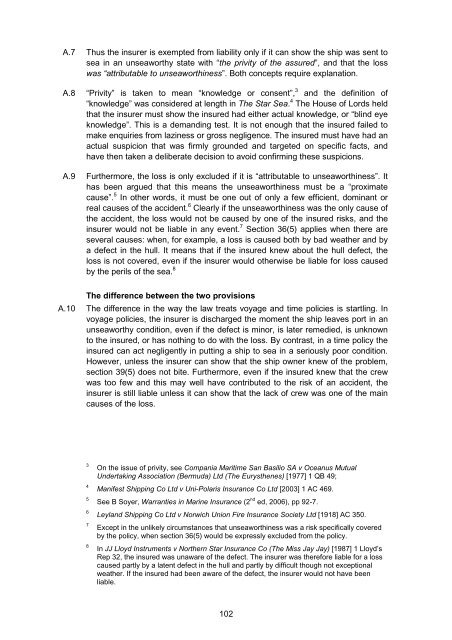Insurance Contract Law Issues Paper 2 Warranties - Law Commission
Insurance Contract Law Issues Paper 2 Warranties - Law Commission
Insurance Contract Law Issues Paper 2 Warranties - Law Commission
Create successful ePaper yourself
Turn your PDF publications into a flip-book with our unique Google optimized e-Paper software.
A.7 Thus the insurer is exempted from liability only if it can show the ship was sent to<br />
sea in an unseaworthy state with “the privity of the assured”, and that the loss<br />
was “attributable to unseaworthiness”. Both concepts require explanation.<br />
A.8 “Privity” is taken to mean “knowledge or consent”, 3 and the definition of<br />
“knowledge” was considered at length in The Star Sea. 4 The House of Lords held<br />
that the insurer must show the insured had either actual knowledge, or “blind eye<br />
knowledge”. This is a demanding test. It is not enough that the insured failed to<br />
make enquiries from laziness or gross negligence. The insured must have had an<br />
actual suspicion that was firmly grounded and targeted on specific facts, and<br />
have then taken a deliberate decision to avoid confirming these suspicions.<br />
A.9 Furthermore, the loss is only excluded if it is “attributable to unseaworthiness”. It<br />
has been argued that this means the unseaworthiness must be a “proximate<br />
cause”. 5 In other words, it must be one out of only a few efficient, dominant or<br />
real causes of the accident. 6 Clearly if the unseaworthiness was the only cause of<br />
the accident, the loss would not be caused by one of the insured risks, and the<br />
insurer would not be liable in any event. 7 Section 36(5) applies when there are<br />
several causes: when, for example, a loss is caused both by bad weather and by<br />
a defect in the hull. It means that if the insured knew about the hull defect, the<br />
loss is not covered, even if the insurer would otherwise be liable for loss caused<br />
by the perils of the sea. 8<br />
The difference between the two provisions<br />
A.10 The difference in the way the law treats voyage and time policies is startling. In<br />
voyage policies, the insurer is discharged the moment the ship leaves port in an<br />
unseaworthy condition, even if the defect is minor, is later remedied, is unknown<br />
to the insured, or has nothing to do with the loss. By contrast, in a time policy the<br />
insured can act negligently in putting a ship to sea in a seriously poor condition.<br />
However, unless the insurer can show that the ship owner knew of the problem,<br />
section 39(5) does not bite. Furthermore, even if the insured knew that the crew<br />
was too few and this may well have contributed to the risk of an accident, the<br />
insurer is still liable unless it can show that the lack of crew was one of the main<br />
causes of the loss.<br />
3 On the issue of privity, see Compania Maritime San Basilio SA v Oceanus Mutual<br />
Undertaking Association (Bermuda) Ltd (The Eurysthenes) [1977] 1 QB 49;<br />
4 Manifest Shipping Co Ltd v Uni-Polaris <strong>Insurance</strong> Co Ltd [2003] 1 AC 469.<br />
5 See B Soyer, <strong>Warranties</strong> in Marine <strong>Insurance</strong> (2 nd ed, 2006), pp 92-7.<br />
6<br />
Leyland Shipping Co Ltd v Norwich Union Fire <strong>Insurance</strong> Society Ltd [1918] AC 350.<br />
7 Except in the unlikely circumstances that unseaworthiness was a risk specifically covered<br />
by the policy, when section 36(5) would be expressly excluded from the policy.<br />
8<br />
In JJ Lloyd Instruments v Northern Star <strong>Insurance</strong> Co (The Miss Jay Jay) [1987] 1 Lloyd’s<br />
Rep 32, the insured was unaware of the defect. The insurer was therefore liable for a loss<br />
caused partly by a latent defect in the hull and partly by difficult though not exceptional<br />
weather. If the insured had been aware of the defect, the insurer would not have been<br />
liable.<br />
102

















